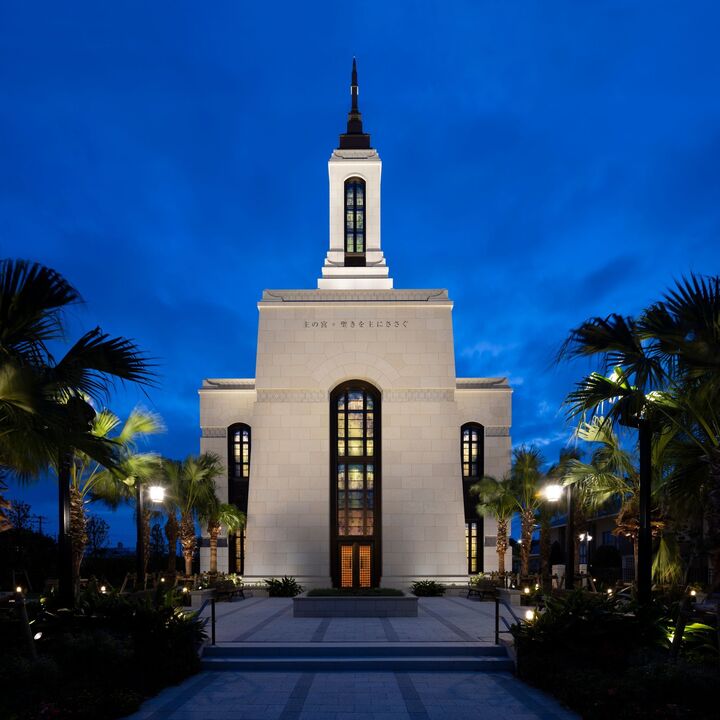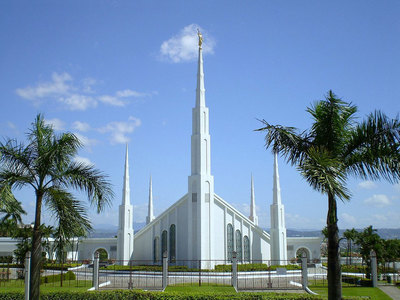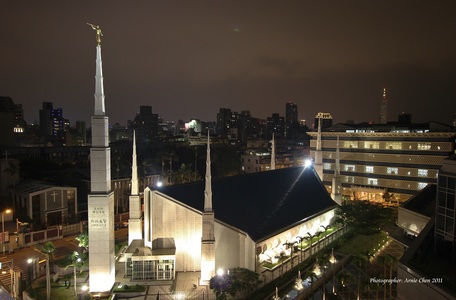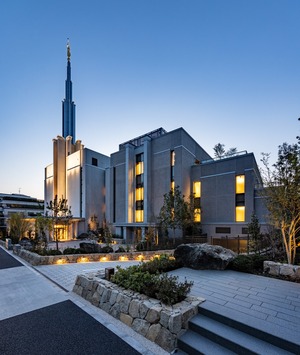Address
7-11-32 MatsumotoOkinawa-shi, Okinawa-ken, Okinawa 904-2151
Japan
Telephone: (+81) 98-993-9870
Services
NO visitors' center open to the publicNO arrival center available
NO patron housing available
Distribution center on site (Store Locator)
Announcement:
7 April 2019Groundbreaking and Site Dedication:
5 December 2020 by Takashi WadaPublic Open House:
23 September–7 October 2023Dedication:
12 November 2023 by Gary E. StevensonSite:
0.55 acres | 0.2 hectaresExterior Finish:
Sunset Gold Chinese granite from Wenshang, Shandong ProvinceArchitectural Features:
Single attached end spireOrdinance Rooms:
One instruction room, one sealing room, and one baptistryTotal Floor Area:
12,437 square feet | 1,155 square metersHeight:
105 feet | 32.0 metersElevation:
141 feet | 43 metersTemple Locale
Located in Okinawa City near the Kadena Air Base, the beautiful Okinawa Japan Temple reflects Japanese architecture, featuring floral designs inspired by the annual blossoming of trees in Okinawa and a stop-stone detail inspired by traditional Shibi Japanese roof tiles. The temple is easily accessible from the Okinawa Expressway and stands next to the Okinawa Ward meetinghouse, which features a patron arrival center. The design of the temple complements the surrounding landscape and provides a serene environment for members to worship in.
Temple Facts
The Okinawa Japan Temple was the fourth temple built in Japan, following the Tokyo Japan Temple (1980), the Fukuoka Japan Temple (2000), and the Sapporo Japan Temple (2016).
Temple History
Announcement
On April 7, 2019, President Russell M. Nelson announced plans to construct Japan's fourth temple, the Okinawa Japan Temple, at the 189th Annual General Conference. Okinawa Island is the largest of the Ryukyu Islands—an island group that stretches from Kyushu, the island where the Fukuoka Japan Temple is located, to Taiwan, the island where the Taipei Taiwan Temple is located. The Church has had a presence in Japan since 1901. At the time of the announcement, there were nearly 130,000 Latter-day Saints in the country. One stake and one military district operated in Okinawa. The island is famous for having some of the longest living people in the world.1
Site and Rendering
On May 25, 2020, the location of the Okinawa Japan Temple was released along with the official exterior rendering. The two-story, 12,437-square-foot temple would be constructed in Okinawa City near the Kadena Air Base, adjacent to the meetinghouse for the Okinawa Ward, which would be remodeled to include a temple patron arrival center. Its location, just off the Okinawa Expressway, would make the temple easily accessible from locations throughout the island.2
Groundbreaking
"Despite the small gathering, we are extremely grateful as we meet to consecrate this island for the building of a holy temple this day," said Elder Takashi Wada, Asia North Area president, who presided at the groundbreaking ceremony for the Okinawa Japan Temple on Saturday, December 5, 2020. The two-story, 12,437-square-foot temple would be constructed on half-acre parking lot next to an existing meetinghouse that would be remodeled to include a patron waiting area. In his dedicatory prayer, Elder Wada prayed, "Please watch over the people on this island; may all be inspired by thy spirit and recognize the eternal significance of this sacred project."3
Open House
The public was invited to tour the newly completed Okinawa Japan Temple of The Church of Jesus Christ of Latter-day Saints during an open house held from Saturday, September 23 through Saturday, October 7, 2023, with no tours held on Sundays. Before the public portion of the open house, a media day was held on Thursday, September 21, and invited guest tours were held on Friday, September 22.4 Nearly 8,000 people toured the interior of this house of the Lord.
Dedication
The temple was be dedicated by Elder Gary E. Stevenson of the Quorum of the Twelve Apostles in two sessions—one in Japanese and one in English—at 10:00 a.m. and 1:30 p.m. on Sunday, November 12, 2023. The final battle of World War II, which took place in Okinawa, claimed the lives of 240,000 Japanese and U.S. servicemen and Okinawan civilians. Akira Yafuso, an early stake president in Okinawa, said: "I believe and I feel that this land of Okinawa is purified or sanctified by the blood of these ancestors and military personnel. And now it is so great to have a house of the Lord in Okinawa, to have a symbol of peace. We want to be the Lord's temple-loving people."5
Temple Design
Exterior
The exterior design is drawn from traditional Okinawan and Japanese architecture. The segmented arches over the windows are inspired by portals in traditional stone walls, like those at the Shurijo Castle, Nakagusuku Castle, and Sogenji Temple. The decorative floral band that connects the arches alludes to the traditional karamon (gate) found in important Japanese gateways. The structure consists of reinforced concrete with a granite exterior. The stone is Sunset Gold Chinese granite from Wenshang, Shandong Province.
Matt McNicholas from MGLM Architects designed the art glass under direction from Michael Thomson, Kathleen Lewis, Russell Hansen and Melanie Jones. The art glass design is inspired by traditional Okinawan bingata stencils and patterns. The art glass was fabricated by Savoy Studios of Portland, Oregon.
To match the tropical location, many native plants adorn the temple, such as fountain palms, sago palms, and Chinese hibiscus. The back of the temple features a Japanese rock garden. MGB+A, located in Salt Lake City, Utah, was the landscape designer for the first stage of the design. D+M, located in Tokyo, Japan, finished the project.
Interior
The flooring materials include a combination of stone, porcelain and ceramic tiles, and area rugs. The area rugs adorn the entry and the instruction, celestial and sealing rooms. They were custom designed with Rugs International, headquartered in Cartersville, Georgia. The stone flooring is Branco do Mar limestone from Portugal, and Dekton Sasea ceramic tiles are used in support areas.
The temple’s ceilings are constructed using gypsum board with crown moldings. Decorative paint features, including geometric flower patterns, are composed of gold, blue and white.
The temple’s art glass is inspired by bingata artwork, which originates in Okinawa. It is made from three panes of painted glass, each pane painted with a different design, giving the art glass a different appearance depending on whether it is viewed from outside or inside the temple. The outer pane features a green and lavender floral pattern. The center panel is painted with blue and lavender flowers with green leaves, very similar to bingata flowers. The inner panel has a dark blue drape descending from the top of the window.
The stair hall was designed as an origami-inspired piece; the second floor folds down to the first floor and appears to float from the adjacent wall. The elements are precisely aligned and paired to make the stair visually as light as possible.
Geometric floral and weave patterns are included in the lighting design. The decorative lighting fixtures were manufactured by Yamagiwa, based in Japan.
The font railings were fabricated in Japan. The railing has a simple, sleek design, with green art glass accents in the corners surrounding the larger glass panels.
The walls are painted throughout the building. Ordinance rooms have decorative millwork panels, beech wood paneling, stone paneling, and stone window surrounds. The patterning on the paneled walls reflects the grid patterns often found in Japanese architecture and interior design.
The temple doors are made from stained European beech. Some doors feature an art glass transom and visibility panel. The hardware is brass and has a sleek rectangular design with notched corners.
The temple’s original artwork includes “Waterfall” by Keith Bond and “Earth Behold Him!” by Joshua Clare.
Church History in Okinawa
The first missionaries of The Church of Jesus Christ of Latter-day Saints landed in Tokyo, Japan, in 1901. In 1945, during World War II, American servicemen were the first Church members to arrive in Okinawa. Since then, American and Japanese Latter-day Saints have shared a joint role in Church service and growth in the Ryukyu Islands.
On July 8, 1945, just a few days after the Battle of Okinawa ended, a conference was held for Latter-day Saint servicemen at Nakagusuku Castle, with 180 attendees. Future Church Apostles Neal A. Maxwell and Boyd K. Packer served in Okinawa during this time, and they later spoke about personal spiritual experiences on the islands during the war.
Latter-day Saint servicemen residing in Okinawa in the years following World War II met for regular Church meetings and conferences, often at Kadena Air Base and later at the Camp Kuwae chapel. Okinawa was added to the Japanese Mission on June 23, 1951. Eventually, on November 2, 1952, the Okinawa Servicemen’s District was created. Today it is the Okinawa Japan Military District and continues to serve English-speaking Church members in Okinawa.
On August 14, 1955, Elder Joseph Fielding Smith formally dedicated Okinawa for the preaching of the gospel at a special meeting near the Zukeran military base chapel. American servicemen in Okinawa shared the gospel with local Japanese people even before proselytizing efforts were officially organized. The first Japanese members were baptized December 25, 1955. Their baptisms inspired the mission president to send the first assigned missionaries to Okinawa on April 17, 1956.
In 1956, Latter-day Saint servicemen broke ground for a chapel in Futenma and moved a Quonset hut donated by the military to the site. American and Japanese Church members alike eagerly raised funds for the future building. Eventually, the first full-sized chapel for the Japanese Saints was erected in Naha and dedicated by Elder Gordon B. Hinckley on October 16, 1966.
Military members of the Church in Okinawa continued to fluctuate in the decades after the war due to the transient nature of assignments. However, in 1962 the number of Japanese Church members reached 94 at the Futenma Military Branch and 172 at the new Naha Servicemen Branch. Significant growth continued, and in 1963 there were 134 members in Futenma and 252 in Naha.
Full-time missionaries often served as branch and district leaders in Japanese-speaking congregations until May 7, 1961, when the first Japanese branch president was instated in the Naha branch. Just over a year later, on November 18, 1962, a Japanese member was called as the 12th district president, the first local to fill this role. Under the direction of faithful local leaders, missionary work blossomed.
Church congregations spread to surrounding islands, and congregations were formed in Ishigaki, Miyakojima and Amami Island, where Elder Gary E. Stevenson, future Church Apostle, served as a young missionary in 1975.
On October 23, 1980, the long-awaited Japanese-speaking Okinawa Japan Stake was organized by Elder Ezra Taft Benson, President of the Quorum of the Twelve Apostles. The first stake president had served as the district president for many years. By this time, the number of Japanese Church members had reached 1,873.
The combined synergy and respect between American military district members and Japanese stake
members continued, furthering the Lord’s work in Okinawa. Unity among American and Japanese Saints has been a continuous theme on the island.
Church leaders have regularly visited Okinawa, including President Gordon B. Hinckley, who came five times as an Apostle between 1960 and 1976. He traveled to Okinawa again in 1996 as President of the Church.
Temple and family history work has always been part of the legacy of the Ryukyu Islands, which were ruled through the centuries by various nations. Valiant men and women from many countries gave their lives, and their spirits instill a sacred urgency for temple work among those who live in Okinawa.
Early Okinawan Saints traveled to Laie, Hawaii, to participate in temple ordinances. Later, the Tokyo Japan Temple was announced in 1975 and dedicated in 1980. This temple, though in Japan, still required a notable sacrifice for members to attend, so Okinawan Saints also served in the Manila Philippines Temple, the Taipei Taiwan Temple, and eventually the Fukuoka Japan Temple, dedicated in 2000.
The former president of the Okinawa stake and of the Tokyo temple noted that upon hearing the announcement of the Okinawa Japan Temple in April 2019, he “was filled with great joy and gratitude with many of my brothers and sisters. Okinawa is an island which is redeemed by the precious blood of more than 240,000 people during the war. During my tenure as stake president, the cries of the dead, who had already accepted the gospel in the spirit world, were as urgent as the tides of the sea.”
The Okinawa Japan Stake and Okinawa Japan Military District now share a combined 5,500 members in 12 congregations. Chapels have been constructed in Nago, Naha, Okinawa, Futenma, Itoman and Ishigaki. As a whole, Japan is home to more than 130,000 Latter-day Saints in over 230 congregations.
The Okinawa Japan Temple, the fourth temple in Japan, was announced on April 7, 2019, by Church President Russell M. Nelson. Ground was broken on December 5, 2020, and the temple will be dedicated November 12, 2023. The temple will serve Church members living in Okinawa and on the surrounding islands.
- "Prophet Announces Eight New Temples at April 2019 General Conference," The Church of Jesus Christ of Latter-day Saints News Release, 7 Apr. 2019.
- "See What the New Temples in Guatemala and Japan Will Look Like," The Church of Jesus Christ of Latter-day Saints News Release, 5 May 2020.
- "Okinawa Japan Temple to ‘Bless the Entire Community’," The Church of Jesus Christ of Latter-day Saints News Release, 5 Dec. 2020.
- "News for Temples in Japan and California," The Church of Jesus Christ of Latter-day Saints News Release, 17 Apr. 2023.
- "Elder Stevenson Dedicates Okinawa Japan Temple," The Church of Jesus Christ of Latter-day Saints News Release, 12 Nov. 2023.






